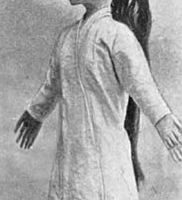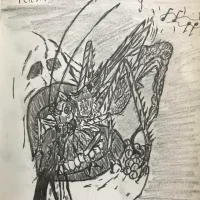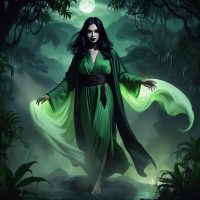Langsuyar : The Malaysian Vampire
Listen
At a glance
| Description | |
|---|---|
| Origin | Malaysian Mythology |
| Classification | Spirits |
| Family Members | N/A |
| Region | Malaysia |
| Associated With | Blood Sucking, Haunting |
Langsuyar
Introduction
The Langsuyar is one of the most haunting and enduring figures in Malaysian and Indonesian mythology. Feared across the Malay Archipelago, she is said to be the spirit of a woman who died during childbirth or shortly after giving birth. Unlike her counterpart, the Pontianak, who represents the spirit of the unborn child, the Langsuyar embodies the sorrow and rage of the mother. Her name is believed to originate from helang, the Malay word for eagle, a reference to her ability to fly through the night. The earliest written mention of the Langsuyar appears in Walter William Skeat’s Malay Magic (1891), which recorded tales of local spirits and beliefs in Selangor. This vampiric entity symbolizes grief transformed into vengeance, an eternal echo of pain that continues to fascinate and terrify.
Physical Traits
Descriptions of the Langsuyar vary across regions, but they all paint a picture of unsettling beauty. She appears as a tall, ethereal woman with long, flowing black hair that reaches her ankles, often wearing a green robe that shimmers in the moonlight. Her nails are long and sharp, resembling claws capable of tearing flesh. Some accounts add that she has red eyes that glow in darkness and fangs hidden behind a deceptively charming smile. In several traditions, she has a small hole at the back of her neck, through which she drinks the blood of infants.
When angered, the Langsuyar sheds her human-like appearance and becomes a monstrous apparition with unkempt hair and talon-like hands. Certain folk tales even describe her as being able to transform into an owl or a shadowy bird that hovers over villages at night, marking her victims with eerie cries. The association between the Langsuyar and owls runs deep in Malay folklore—an owl’s call near a house where a woman has recently given birth is often considered a bad omen, signaling her presence.
Family
The Langsuyar’s story is deeply rooted in themes of maternal loss and despair. She is said to be a woman who died during childbirth, and forty days after burial, her spirit rises as a Langsuyar if proper rituals are not performed. In contrast to the Pontianak, who is the spirit of the stillborn child, the Langsuyar is the mourning mother whose grief curdles into wrath. In some versions, her child becomes a Pontianak, and the two exist as spectral counterparts—a tragic mother-and-child pair eternally separated by death.
Some myths also suggest that betrayal contributes to her transformation. A husband’s infidelity or abandonment during pregnancy intensifies her anguish, turning maternal love into unending vengeance. Her haunting, therefore, represents both personal grief and the collective fear surrounding childbirth and maternal mortality in traditional societies.
Other names
The Langsuyar is known by several spellings and variations depending on regional dialects and oral traditions—Langsuir, Lang Suir, Langsuior, and Langsoir are among the most common. In Malaysia, she is often referred to as Hantu Langsuir, with hantu meaning ghost or spirit. Despite being confused with other Southeast Asian spirits such as the Pontianak, Kuntilanak, or Penanggalan, the Langsuyar remains distinct in her origin and characteristics.
Her name’s root in helang emphasizes her connection to flight and predation. Much like the eagle that swoops down on its prey, the Langsuyar is said to descend silently upon the unsuspecting, feeding on life essence. This linguistic link also reflects how the Malays often associated spiritual beings with elements of the natural world—turning familiar animals into symbols of the supernatural.
Powers and Abilities
The Langsuyar possesses powers typical of vampiric entities but infused with local cultural symbolism. She is said to fly effortlessly through the night, sometimes transforming into an owl or a misty shadow to move between realms. Her most feared ability is her thirst for blood, particularly that of newborns and young men. Instead of fangs, she feeds through the hole at the back of her neck, a gruesome detail that sets her apart from Western vampire lore.
She is also known to possess mesmerizing beauty and an enchanting voice capable of luring victims into the forest. Once close enough, her true form is revealed—her face twisted, her nails elongated, and her laughter echoing like a banshee’s cry. In some regions, she can drain the life force from victims without leaving visible wounds, making her attacks almost impossible to detect.
Traditional Malay beliefs included several preventive rituals to stop a woman from turning into a Langsuyar. After death, family members might place glass beads in her mouth, chicken eggs under her armpits, and steel needles in her palms to prevent the corpse from becoming restless. It was believed that if her nails and hair were cut and stuffed into the neck cavity, the Langsuyar would lose her powers and revert to a normal woman. However, folklore warns that if she ever experiences joy again—especially through dance—her supernatural form will return.
Modern Day Influence
The Langsuyar’s legend continues to resonate in contemporary Malaysia, symbolizing both the fear of death and the enduring strength of feminine rage. She remains a popular figure in ghost stories told during festivals like the Hungry Ghost Month and continues to appear in horror cinema and literature. The 2018 Malaysian film Langsuir retells her story as a tragic romance between a man and the spirit of a woman trapped between love and vengeance.
Modern interpretations of the Langsuyar have evolved beyond horror. In academic studies, she is analyzed as a metaphor for women’s suffering and silence, especially in patriarchal societies where female autonomy was historically constrained. Artists and filmmakers reinterpret her not just as a monster but as a symbol of resistance—an embodiment of suppressed pain that refuses to fade quietly.
Her presence is also felt in online storytelling, podcasts, and video games that explore Southeast Asian mythology. International audiences are increasingly discovering her through digital horror anthologies, folklore documentaries, and regional art exhibitions that celebrate Malaysia’s supernatural heritage.
In contemporary discussions, the Langsuyar represents more than just a ghost story—she stands as a cultural reflection of the intersection between myth, gender, and mortality. Her evolution from a rural tale whispered in village night markets to a recurring figure in global horror demonstrates how folklore adapts to survive in modern consciousness.
The Langsuyar’s chilling legend continues to captivate because it speaks to universal fears—loss, betrayal, and the fragile line between love and vengeance. She is both a cautionary tale and a timeless symbol of how grief, when left unresolved, can transform into something both beautiful and deadly. Through her story, Malaysian mythology preserves an ancient truth: that even in death, emotion and memory can linger, taking form in the restless wings of the Langsuyar.
In popular culture, Heqet appears in books, video games, and educational series on Egyptian mythology, often depicted as a benevolent force of life and renewal. Her influence even finds echoes in unexpected places—such as the internet’s fascination with frog symbolism—where the ancient association between frogs, rebirth, and mysticism subtly persists.
Related Images
Source
Illes, J. (2009). Encyclopedia of Spirits: The Ultimate Guide to the Magic of Fairies, Genies, Demons, Ghosts, Gods & Goddesses. HarperOne.
Skeat, W. W. (1891). Malay Magic: An Introduction to the Folklore and Popular Religion of the Malay Peninsula. Macmillan.
Monstropedia.org. (2008). Langsuir. Retrieved from https://www.monstropedia.org/index.php/Langsuir
Harms, E. (2021). Langsuyar. Retrieved from https://eveharms.com/2021/10/04/langsuyar
Sinardaily. (2025). Ghost stories Malaysians grew up hearing. Retrieved from https://www.sinardaily.my/article/225939
Hernandez, J. A. (2022). Langsuyar of Malaysian Folklore. Retrieved from https://www.jahernandez.com/posts/langsuyar-of-malaysian-folklore
Dutta, T. (2015). Halloween 2015: The Langsuir. Retrieved from http://tutudutta.blogspot.com/2015/10/halloween-2015-langsuir.html
Pantheon.org. (2006). Langsuir | Facts, Information, and Mythology. Retrieved from https://pantheon.org/articles/l/langsuir.html
Frequently Asked Questions
What is lorem Ipsum?
I am text block. Click edit button to change this text. Lorem ipsum dolor sit amet, consectetur adipiscing elit. Ut elit tellus, luctus nec ullamcorper mattis, pulvinar dapibus leo.
What is lorem Ipsum?
I am text block. Click edit button to change this text. Lorem ipsum dolor sit amet, consectetur adipiscing elit. Ut elit tellus, luctus nec ullamcorper mattis, pulvinar dapibus leo.
What is lorem Ipsum?
I am text block. Click edit button to change this text. Lorem ipsum dolor sit amet, consectetur adipiscing elit. Ut elit tellus, luctus nec ullamcorper mattis, pulvinar dapibus leo.
What is lorem Ipsum?
I am text block. Click edit button to change this text. Lorem ipsum dolor sit amet, consectetur adipiscing elit. Ut elit tellus, luctus nec ullamcorper mattis, pulvinar dapibus leo.
What is lorem Ipsum?
I am text block. Click edit button to change this text. Lorem ipsum dolor sit amet, consectetur adipiscing elit. Ut elit tellus, luctus nec ullamcorper mattis, pulvinar dapibus leo.







